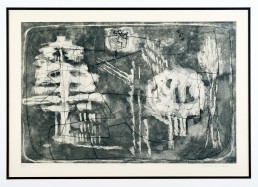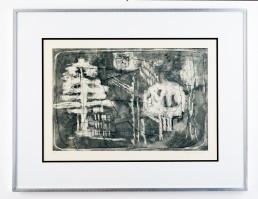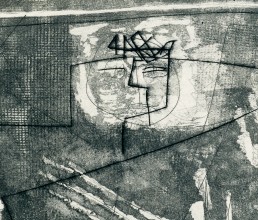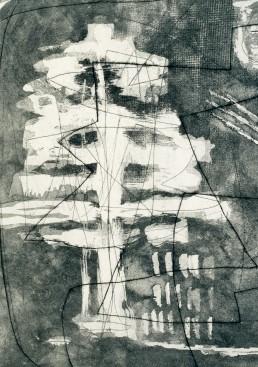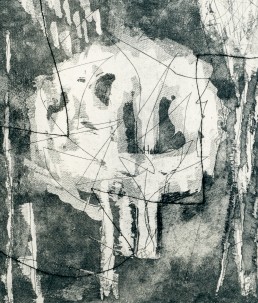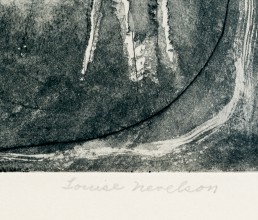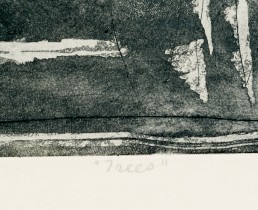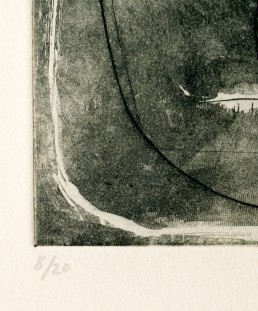Poetic Etching by Louise Nevelson
Louise Nevelson (1899 – 1988)
A complex black and white etching with subtle aquatint, “Trees” flattens Nevelson’s traditional preoccupation with volume and texture. In it, she juxtaposes a vigorous abstract line drawing and a dreamlike landscape of ghostly figuratition, layered over a shadowy, tactile background. Long hailed for her sculpture, Nevelson also pursued new creative languages throughout her life. In the immediacy of printmaking, she found freedom, intuition, and a joy this piece makes clear.
Signed, titled, and numbered 8/20.
Excellent vintage condition. Piece is matted and framed.
- Origin: U.S.
- Period: c. 1965
- Dimensions: 13.5" x 20.5" (plate)
- Materials: Etching and aquatint
- Condition: Excellent
Out of stock
Product Description
A complex black and white etching with subtle aquatint, “Trees” flattens Nevelson’s traditional preoccupation with volume and texture. In it, she layers a vigorous abstract tracery over a dreamlike landscape of ghostly figurative shapes, undergirded by a shadowy, tactile background. The piece makes clear the freedom, intuition, and joy provided by the medium’s immediacy.
LOUISE NEVELSON (American, 1899-1988)
Etching and aquatint; “Trees,” ca. 1965 (framed); Signed, titled and numbered 8/20; 13 1/2″ x 20 1/2″ (plate)
these figurative etchings that reflect Nevelson’s absorption and interpretation of Abstraction, African and Pre-Columbian art
Her first forays into printmaking occurred at Atelier 17, New York, with Stanley William Hayter. She visited Hayter in the mid 1940s but did not formally start work until 1953 when over a three year period she composed thirty black and white etchings. Emiliano Sironi printed these etchings under the supervision of Irwin Hollander at the Hollander Graphic Workshop, New York in 1965.
At Pace Primitive eight of these figurative etchings that reflect Nevelson’s absorption and interpretation of Abstraction, African and Pre-Columbian art, will be juxtaposed with a selection of African and Oceanic art. In the etchings Jungle Figures, The Search and Solid Reflections Nevelson deconstructs form and volume into her own visual manifestations, which preclude her large sculptures.
Nevelson experimented in several different print mediums. A 1963 Ford Foundation grant enabled June Wayne of the Tamarind Lithography Workshop, Los Angeles, to extend an invitation to Nevelson. This initial collaboration led to twenty six lithographs, mostly black with dark blue or red, which combined hand-drawn elements with printed lace. Nevelson returned to Tamarind in 1967 to complete sixteen large scale lithographs know as Double Imagery. In these lithographs Nevelson played with landscapes of shadows and reflections using irregular shaped papers and a limited palette of black, red, grey and blue. The irregular shaped components, or “flaps,” are blotted rather than printed images. The flaps were placed face down on the wet lithograph and run through the press, which created a second light impression of the printed image underneath. The immediacy of lithography allowed Nevelson to create freely and intuitively.
In 1970 Nevelson began her publishing association with Pace Editions, Inc., which would last the rest of her career. Her first project with Pace was a series of six lead intaglio relief prints executed in 1970-1973 at Sergio and Fausta Tosi’s workshop in Milan, Italy. These prints along with the cast paper pulp pieces most resemble her iconic sculptures. To create the lead intaglio prints, Nevelson assembled the wood relief elements into her desired vertical composition, which included ten to sixteen pieces each, and were then bonded to a wood backing. At Tosi thin pieces of lead were applied over the maquettes, embossing them. The lead reliefs were then attached to heavy rag paper. The play of light across the shiny and matte areas of the lead form another dimension within the print validating their titles: Sky Shadow, Tropical Leaves, Night Tree, Sky Garden, Night Sound and The Great Wall.
Building on the use of wood relief elements, Nevelson worked again with wood maquettes and this time, cast paper pulp. Nevelson composed eleven cast paper pulp prints between 1975 and 1982. Once more, she translated her sculptural aesthetic into the print medium. When the wood maquettes were complete a rubber mold was formed from them in which the paper pulp was pressed and left to dry. The use of cast paper imbues a tactile, organic quality to the work.
Most of the cast paper pieces are all white or all black, eliminating the original frame of reference and giving the viewer insight into Nevelson’s vision. The titles convey the romance and mystery of dawn, night and celestial bodies: Dawn’s Presence, Dawnscape, Morning Haze, Moon Garden and Nightscape.
Nevelson returned to the mediums of etching and aquatint in three different series: Celebrations, 1979; Tonalities, 1981; and Reflections, 1983. These suites used torn colored papers, lace, doilies, with etching and aquatint to produce abstract, colorful collages.
Moving from printed matter to multiples, Nevelson conceived ten pieces made of wood and polyester cast resin. The multiples evoke their own microcosms of texture, shadow and reflection. Dark Ellipse, 1974, a totemic, free-standing piece absorbs the viewer leading one to explore its curves and surfaces. These multiples stand on their own as sculptural objects.
Most of the cast paper pieces are all white or all black, eliminating the original frame of reference and giving the viewer insight into Nevelson’s vision. The titles convey the romance and mystery of dawn, night and celestial bodies: Dawn’s Presence, Dawnscape, Morning Haze, Moon Garden and Nightscape. Nevelson returned to the mediums of etching and aquatint in three different series: Celebrations, 1979; Tonalities, 1981; and Reflections, 1983. These suites used torn colored papers, lace, doilies, with etching and aquatint to produce abstract, colorful collages. Moving from printed matter to multiples, Nevelson conceived ten pieces made of wood and polyester cast resin. The multiples evoke their own microcosms of texture, shadow and reflection. Dark Ellipse, 1974, a totemic, free-standing piece absorbs the viewer leading one to explore its curves and surfaces. These multiples stand on their own as sculptural objects. In printmaking Nevelson found a venue for her intuitive power and creativity establishing a new idiom.

